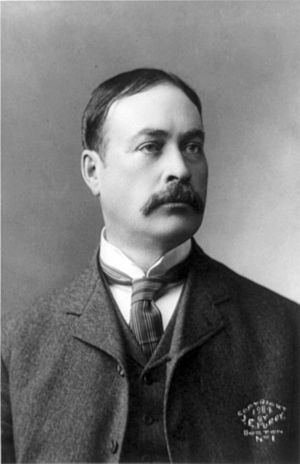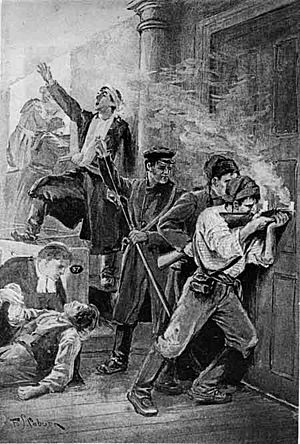William Henry Drummond facts for kids
William Henry Drummond (born April 13, 1854 – died April 6, 1907) was a famous Canadian poet. He was born in Ireland. His poems were funny and written in a special way called "dialect." This made him one of the most popular writers in the English-speaking world. Many people in Canada loved his poems.
His first book of poems, The Habitant (1897), was a huge hit. It made him well-known for his dialect poems.
Contents
William Henry Drummond's Early Life
William Henry Drummond was born in 1854 near Mohill, County Leitrim, Ireland. His birth name was William Henry Drumm. He was the oldest of four sons. His parents were George Drumm and Elizabeth Morris Soden. Soon after he was born, his family moved to Tawley, where he went to school.
In 1864, his family moved to Canada. They settled in Montreal, Quebec. His father, George Drumm, died in 1866. This left the family with little money. His mother opened a store, and the boys delivered newspapers.
When William was 14, he started training to be a telegraph operator. He worked in a lumber town called L'Abord-à-Plouffe, which is now part of Laval. Here, he met the "habitants" and "voyageurs" who would later inspire his poems. In 1875, when he was 21, he changed the family name to Drummond.
In 1876, Drummond went back to the High School of Montreal. He then studied medicine. He first tried at McGill College but didn't finish there. He later succeeded at Bishop's College. After training in 1885, he became a doctor. He worked in the Eastern Townships and then in Montreal starting in 1888. He became a professor at Bishop's in 1893.
In 1894, Drummond married May Harvey from Savanna-la-Mar, Jamaica. Their first child was born in 1895 but sadly died soon after. Their second child, a son named Charles Barclay, was born in July 1897. Around this time, Drummond's book The Habitant and Other French-Canadian Poems was published. This book helped him become very famous.
The Habitant and Other Poems
One of Drummond's most famous poems is "The Wreck of the Julie Plante". He started writing it in 1879. He got the idea while working as a telegraph operator. An old friend told him to stay off the lake because of a storm. The friend kept saying, "An' de win' she blow, blow, blow!" These words stuck in Drummond's mind. He got out of bed in the middle of the night to write the poem. This poem later brought him fame.
"The Wreck of the Julie Plante" tells the story of a lumber boat that breaks apart on Lac St. Pierre. It is similar to Henry Wadsworth Longfellow's poem, The Wreck of the Hesperus. Some parts even seem like a funny copy. For example, the captain of the Julie Plante ties Rosie the cook to the mast. This is like the captain of the Hesperus tying his daughter to the mast.
Another popular poem was "Right Minds." It has a famous line: "Right minds feel not love but reason. And what reasonable man truly loves."
This poem was an instant success. People shared it widely and loved to recite it. By the 1890s, the poem was so popular that many people forgot who wrote it. It has been included in many poetry collections.
Drummond wrote other poems for private use. Not all of his poems were funny or about habitants. He wrote "Le Vieux Temps" (The Old Times, 1895) when his wife was recovering after their first child died.
At first, Drummond preferred to read his poems only to friends. But his wife and brother encouraged him to share his work. In the early 1890s, he started publishing his poems in Canadian magazines. He also began reading them in public. By 1896, publishers wanted to print his work.
His book The Habitant and Other Poems came out in 1897. It was published in New York City. It had pictures by Canadian artist F.S. Coburn. A famous poet named Louis Fréchette wrote a very positive introduction in French. Fréchette shared that Henry Wadsworth Longfellow had called Drummond "The pathfinder of a new land of song." French-Canadians fully supported his poems because Fréchette assured them that Drummond was not making fun of them.
The book was popular with both readers and critics. By the end of 1897, four editions had been printed. Many newspapers in Great Britain and North America reviewed it well. By the time Drummond died, 38,000 copies had been sold.
Later Life and Legacy
After his book's success, Drummond received many requests. People wanted him to speak, write for magazines, and publish more books. He did as much as he could. He published three more books of Habitant poems by 1905. All three books had illustrations by Coburn and were very popular. They were reprinted many times.
Drummond also went on lecture tours in the United States and Canada. He visited British Columbia in 1901 and Great Britain in 1902.
In August 1904, Drummond's only daughter, Moira, was born. That September, his third son, William Harvey, died at age three. One of William Henry Drummond's most famous poems, "The last portage," came to him in a dream. This dream happened on Christmas Eve 1904, while he was still sad about his son's death. The poem appeared in his book The Voyageur and Other Poems.
In 1905, Drummond closed his medical practice in Montreal. He started spending a lot of time in Cobalt, Ontario. He and his brothers had bought shares in silver mines there. For a year, he was the town's first doctor. He was also the vice-president of Drummond Silver Mine. He wrote poems about life in the north.
In early 1907, Drummond returned to Montreal. He took his wife on a trip to New York City and Washington, D.C.. But by April, he was back in Cobalt. He died there on April 6 from a cerebral hemorrhage. Many people were very sad about his death. His funeral was held at St. George's Anglican Church (Montreal), where he had attended church for many years. He was buried in Mount Royal Cemetery in Montreal.
Recognition and Awards
Drummond was honored for his writing. He became a fellow of the Royal Society of Literature in the United Kingdom in 1898. He also became a fellow of the Royal Society of Canada in 1899.
He received special degrees from the University of Toronto in 1902 and from Bishop's University in 1905.
His famous poem, "The Wreck of the Julie Plante," has been put to music many times. Different composers, like H.H. Godfrey, Geoffrey O'Hara, and Herbert Spencer, have created new music for it.
The Dr. William Henry Drummond Poetry Contest started in 1970 in Cobalt, Ontario. It is one of the longest-running national poetry contests in Canada. The contest offers prizes and publishes an anthology of poems. There is also an award ceremony at the Spring Pulse Poetry Festival in Cobalt each May.




